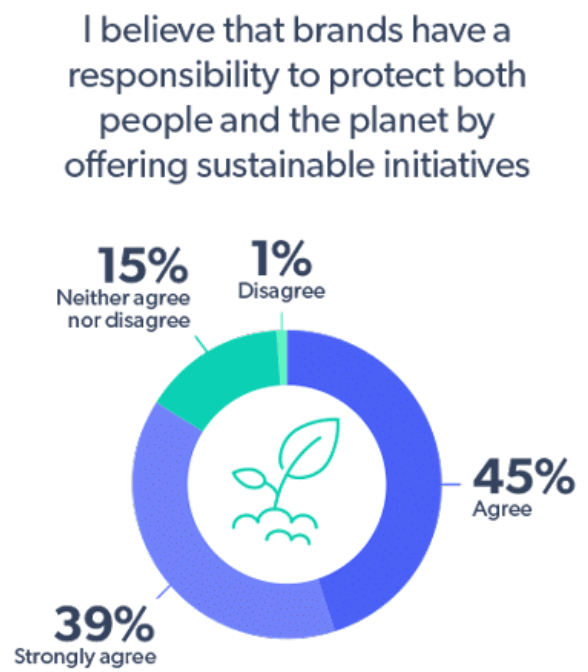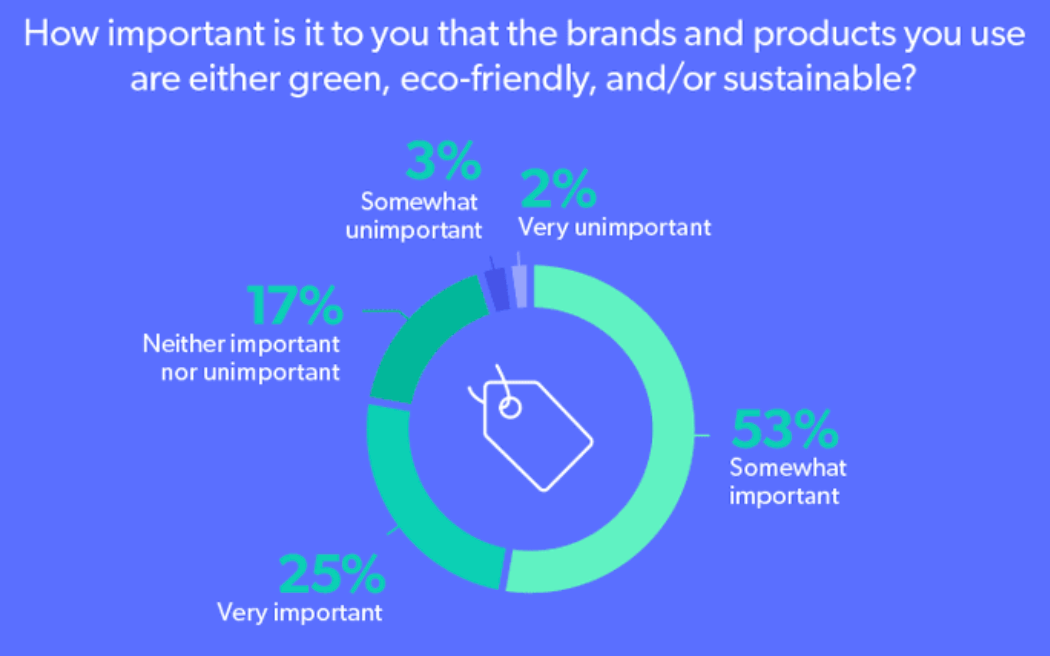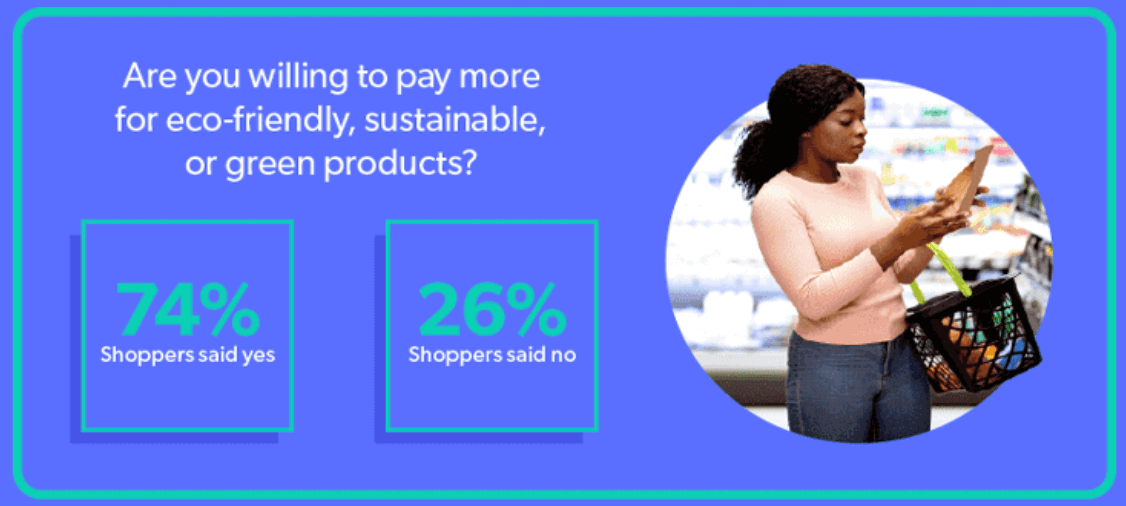August 3, 2022
First of all — why does sustainable branding matter? Well, according to a recent Bazaarvoice survey of nearly 25,000 global consumers:
- 60% of respondents reported that eco-friendly and sustainable products are important to them
- 50% Gen Z and Gen Y respondents are ready to pay more for sustainable clothing
- 35% of respondents have intentionally purchased sustainable clothing made from sustainably-grown material or reused/recycled fabric
And that’s only scratching the sustainability surface. Using our own global research, and insights from industry leaders, we’re going to show you why you need a sustainable branding strategy, and how to implement one.
Chapters:
- What is sustainable branding?
- Why is sustainable branding important?
- Sustainable branding strategy tactics
- How to authentically communicate sustainability practices
- More sustainability, more quality
“Sustainable” is no longer a niche brand category. As the climate movement moves further to the forefront, consumers are expecting brands to make a difference.
Google searches focused on sustainability, including environmental sustainability, increased by 30% in 2021 compared to the previous year. Google also reported that 82% of consumers claim that sustainability is “more top of mind” now compared to the beginning of the pandemic. The majority of these consumers believe that businesses have a responsibility to help with the climate crisis.

To meet consumer demand and clear a progressive and hopeful path to the future, companies need to embrace sustainable branding. The ones that don’t risk rendering themselves irrelevant.
It’s clear that consumers want to make decisions that’ll positively impact environmental, social, and economic issues. Sustainable branding goes beyond merely putting forth a certain image, as consumers are sensitive to greenwashing, and they expect authenticity. Learn how to position your brand as the right choice for them.
What is sustainable branding?
Sustainable branding is the act of embodying sustainability principles throughout a company’s operations, culture, and communications. This includes environmental and social sustainability.
To successfully implement sustainable branding, your company itself needs to be sustainable to some extent and should always be working towards advancing its current practices. Sustainability should be inherent, and the branding piece is how you get the right message out.
Why is sustainable branding important?
Sustainable branding doesn’t only contribute to a healthier planet, it’s good for business. Because it’s what shoppers want to see from the companies they choose to spend money with.
We surveyed over 8,000 North American shoppers to find out more about how they approach sustainability in their shopping habits. You’re going to want to see what they said.


And it’s not just our own research either that supports it. The 2021 Forrester Analytics Consumer Technographics Benchmark Survey reveals just how focused consumers are on the environment and climate change. The results include:
- Approximately two-thirds of online consumers want more transparency from companies around their business practices and hold them responsible for doing their part to protect the environment
- Over half of adult online consumers in the U.S. are worried about climate change’s impact on society. One-third of those say those concerns affect their purchase decisions
- Two out of five U.S. online shoppers want to know the “consequences of their energy choices,” and nearly half seek out energy-efficient labels when making purchases
- Consumers outside the U.S. are even more likely to buy environmentally sustainable products: 49% in the U.K., 60% in France, and 82% in Metro China
- Approximately one-third of U.K. and U.S. consumers, almost half in France, and nearly three-quarters in Metro China declare they’re willing to “pay more for sustainable or environmentally friendly products”
- Environmental responsibility is among the top three factors for U.S. consumers when buying products ranging from consumer electronics to large appliances, cosmetics and beauty products, clothing and accessories, groceries, and more
Clearly consumer demand and purchasing behaviors reflect a desire for sustainable companies and products. If you don’t practice sustainability, you’ll fall behind your competitors.
Tactics for applying a successful sustainable branding strategy
Whether your company needs a complete overhaul to become sustainable or you’ve already made steps in that direction, it can feel like a daunting endeavor. Start with setting realistic goals and milestones to climb up the sustainability ladder. Factor in the following key steps to sustainable branding before you map out your strategy, so you can break it down into manageable pieces.
Convert to a sustainable operation
In order to brand your company as sustainable, you, in fact, need to be sustainable or at least take concrete steps toward it. Begin by focusing on smaller changes you can make throughout your company that align with how consumers are adopting daily habits to support sustainability. For example, your company can switch to recyclable packaging for all of its products and shipping supplies.
There’s many internal modifications retailers can put in place to be more energy efficient, ranging from small to large-scale. In physical stores and warehouses, some of those changes include using LED lighting, converting to solar power, and using battery storage technology — the last of which could decrease in cost by 70% over the next few years. In the transportation area, retailers can commit to only using electric vehicles for company-owned cars and trucks.
To produce sustainable products, you should eliminate harmful plastics and rely on eco-friendly or recycled materials. Ideally, you can use local or domestic manufacturers to cut down on air transportation. All of your facilities should provide high-quality working conditions and fair wages to your employees.
End-to-end sustainability
If you want to go all-in and achieve end-to-end environmental sustainability, you can also require all of your supply chain vendors and partners to meet decarbonization guidelines. The carbon emissions from manufacturing and shipping suppliers are known as Scope 3 emissions, which can make up 80% of the “overall climate impact” for many companies. For home and fashion retailers, in particular, it can be as high as 98%. Amazon and IKEA are examples of companies committing to this level of sustainability by instituting zero-carbon fuels for container shipping by 2040.
You can make achieving a sustainable operation more manageable by dividing and conquering across different company departments, as opposed to creating a separate sustainability department. For example, you can task R&D with researching the best ways you can reduce carbon emissions and what actions to take. The product development department can design and source new products with sustainable materials. The marketing team can promote the company’s sustainable practices, products, and services to generate consumer interest and attract customers.
To steer the sustainability ship, your company might consider appointing or hiring a Chief Sustainability Officer (CSO). An effective CSO can set the overall vision and direction for the sustainability of your company and help to implement it within all the different areas.
Take a holistic approach
Sustainability isn’t just about the environment. It’s also about establishing a healthy social and economic infrastructure. To be fully sustainable, companies have to provide an ongoing quality experience for their employees, business partners, customers, and community — otherwise known as social sustainability. In addition, to be economically sustainable, companies must conserve resources so that those resources will continue to be abundant and available long-term.
CMOs at successfully sustainable companies enact comprehensive sustainability initiatives that go beyond the marketing department. As Forrester observes, “These businesses embark on company wide transformations and have broad approaches to sustainability that aren’t limited to environmental sustainability.” CMOs at these companies bring their knowledge of the customer and employee experience in order to implement sustainable practices across the company.
In addition to the increase in general sustainability searches on Google, searches for “sustainable fashion” increased by 25% in 2020, following its highest search volume on record in 2019, and “sustainable jewelry” increased by a whopping 75% in 2020. Tiffany & Co. is an example of a major luxury brand that is committed to sustainability — meeting the consumer interest in sustainable jewelry.
Brands taking a holistic approach
Through its Tiffany Save the Wild collection, the jewelry brand has raised over $10 million in donations to the Wildlife Conservation Network to protect wildlife in Africa, one of the countries it sources diamonds from. In doing so, it supports the environment and the surrounding community located for one of its primary resources. Tiffany’s organic social content promoting its social and philanthropic campaigns proved to resonate with its audience, resulting in a significant increase in engagement and other KPIs.
Target is a major retailer with a comprehensive sustainability transformation underway called Target Forward, slated to be complete by 2040. This plan took two years to develop and includes insight from different teams throughout the business. The main goals of the sustainability plan are to reduce waste, source products from sustainable companies, produce and sell exclusively sustainable products for its private label brands, and improve its diversity and inclusion program.
As a company and a member of the global community, it’s imperative for the health of both our business and our planet that we embrace new ways to move forward. We know sustainability is tied to business resiliency and growth, and that our size and scale can drive change that is good for all.
Brian Cornell, Chairman and CEO, Target
Its ultimate objective is to become a net-zero corporation by 2040, which entails eliminating waste sent to landfills in the U.S. and eradicating emissions from its operations and supply chain.
In addition to its environmental focus, Target Forward also puts an emphasis on the people involved in its massive operation. Those commitments include fostering an equitable and inclusive working environment in its supply chain, increasing its percentage of BIPOC workers, and instituting gender equity policies for all of its suppliers.
Communicate sustainable practices accurately and authentically
A big part of sustainable branding is communicating your green processes to your audience and your team. As consumers grow more concerned with climate change, they’re paying attention to what brands are doing and how their products impact the environment.
In the above infographic, 62% of consumers say they sometimes seek out eco-friendly information from companies, and 11% always do. So, be sure to make that information easily accessible for your customers.
You want your customers to trust your brand. To earn that trust, you need to be authentic. That means not only practicing what you preach but being fully transparent about what progress you’ve made, even if it’s not much yet.
An effective way to communicate your company’s sustainable practices is to integrate the messaging across all of your marketing materials and channels as a brand standard and not an appendage. It should be a pillar of your brand values and identity. Encourage shoppers to support those initiatives by demonstrating the positive impact your company has on the environment and society. Highlight how they can contribute to the mission instead of guilting them into making sustainable choices.
For example, you can include sustainability details on product pages that highlight natural and locally sourced materials as well as information about where products are made. Sustainable fashion brand Reformation includes a sustainability dropdown menu on all of its product pages. This way, customers can feel good about the choices they’re making. Reformation also has a dedicated sustainability section on their website that details how they make their products and the working conditions they provide for their employees.
Don’t greenwash
Whatever you do, don’t greenwash — out of respect for your audience and your brand’s reputation. Consumers are becoming more aware of companies exaggerating their level of sustainability. According to an Adweek-Morning Consult survey, half of the respondents expressed that brands and agencies should be held legally responsible for spreading misleading environmental claims.
Even as I write this, Asda, Boohoo, and others are currently being investigated by the Competition and Markets Authority over greenwashing claims.
Request input from your customers
Invite your customers to become involved in your sustainability contributions by asking for their feedback on what they’d like to see your company invest in. This can help you identify priorities to guide your strategy and timeline. It’ll also allow you to deliver what matters to your customers.
There’s various different ways to collect customer input. You can leverage post-interaction emails to ask shoppers to fill out a survey after visiting your sustainability page or certain product pages in exchange for a promo code. Another tactic is to post Instagram polls and questions that followers can submit to in your Instagram stories.
You can also inspire your customers to create user-generated content (UGC) to share their sustainably-made purchases online. Through a hashtag campaign, you can ask customers to share photos or videos of their new items and what makes them sustainable. You should also encourage customers to leave product reviews via shipping notification emails or SMS texts. Request that they include the sustainable qualities they appreciate the most about their purchased products in their reviews.
Through these forms of UGC, you can extract valuable insights while receiving free promotion from your own customers. Your customers who share their sustainable items online while tagging your brand or using a branded hashtag will be spreading the word as brand advocates. You can then repurpose this UGC on product pages and elsewhere throughout your website with visual galleries.
Once you have all of this data from your customers, you can uncover knowledge to optimize your sustainability strategy.
Find ways to innovate
As tech continues to advance and the demand for sustainability grows larger, there’s plenty of opportunities for brands to drive innovation. Sustainable apparel brands are eager to offset the considerable waste the fast fashion industry produces. Two of those brands are Pangaia and Unspun, which teamed up to offer their customers eco-friendly products while vastly reducing inventory waste.
The partnership takes the guesswork out of how much inventory to produce, which is a pervasive challenge throughout the apparel industry and leads to massive overproduction. With Unspun’s technology, shoppers can use their mobile app to scan their bodies to order custom-made jeans. Customers are getting tailor-made jeans to order, ensuring no waste, and receiving pants that fit. Unspun uses Pangaia’s material for their jeans, which is entirely plant-based.
Unspun’s innovative technology designs the perfect fit for customers by using a 3D body scan built into its mobile app. The made-to-order denim guarantees no unnecessary waste.
Grove Collaborative is another innovative example of a brand whose entire business model centers around sustainability. Grove presents their products as one solution to the global plastic waste problem, which contributes to significant land and ocean pollution. The brand commits to being a 100% plastic free company by 2025.
Grove produces waste-free home and wellness products, including laundry, cleaning, personal care, storage, pet, and gardening supplies. Their products all meet strict sustainability standards, including natural ingredients and reusable packaging.
Being sustainable doesn’t mean sacrificing quality
Actually, it’s quite the opposite. Just because you are becoming more sustainable doesn’t mean you have to abandon your other product quality standards, brand voice, style, or aesthetic. And your customers don’t want you to.
Out of the consumers surveyed in our sustainability study above, 67% said they wouldn’t buy green products if they performed worse than alternatives. Being sustainable means evolving your brand and products. That will also mean making adjustments, but there’s no growth without change.
Here’s to a sustainable future for your brand, your customers, and the planet.










